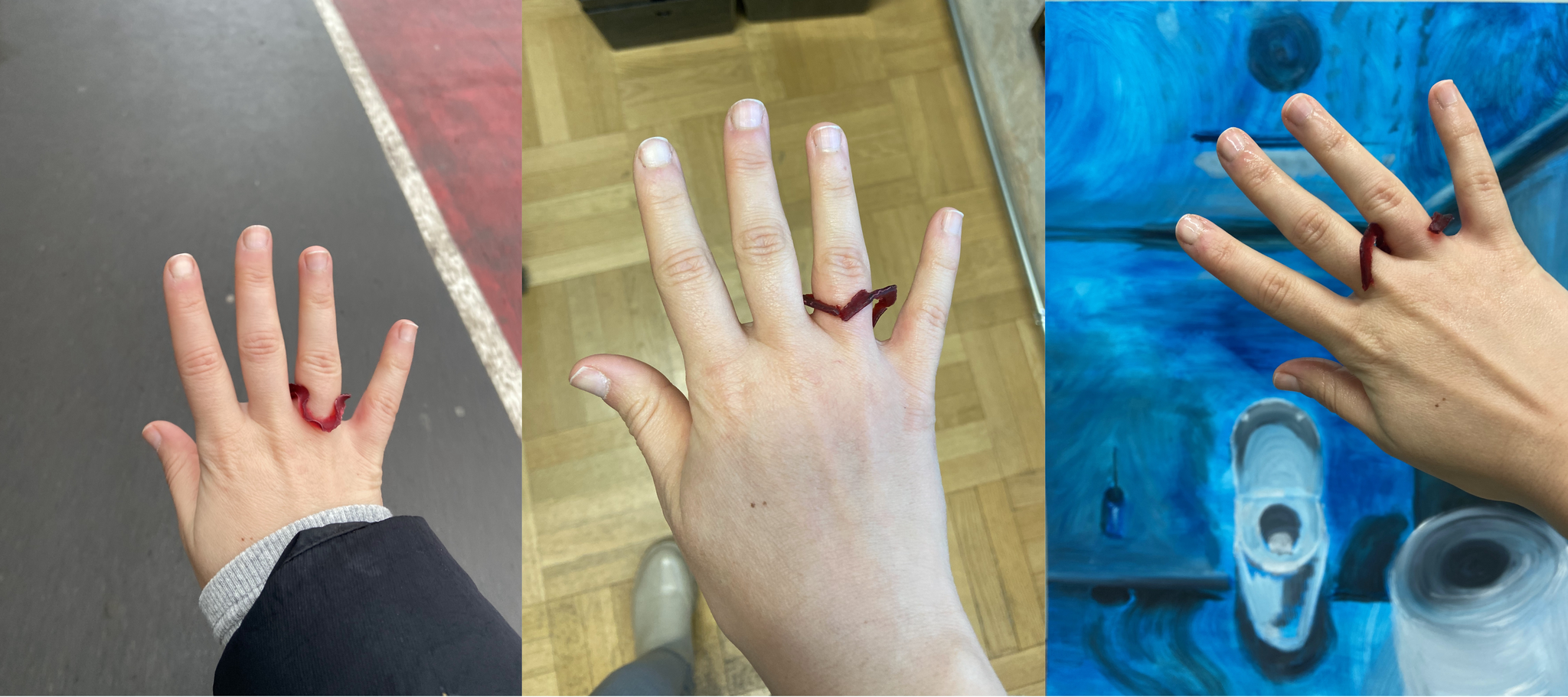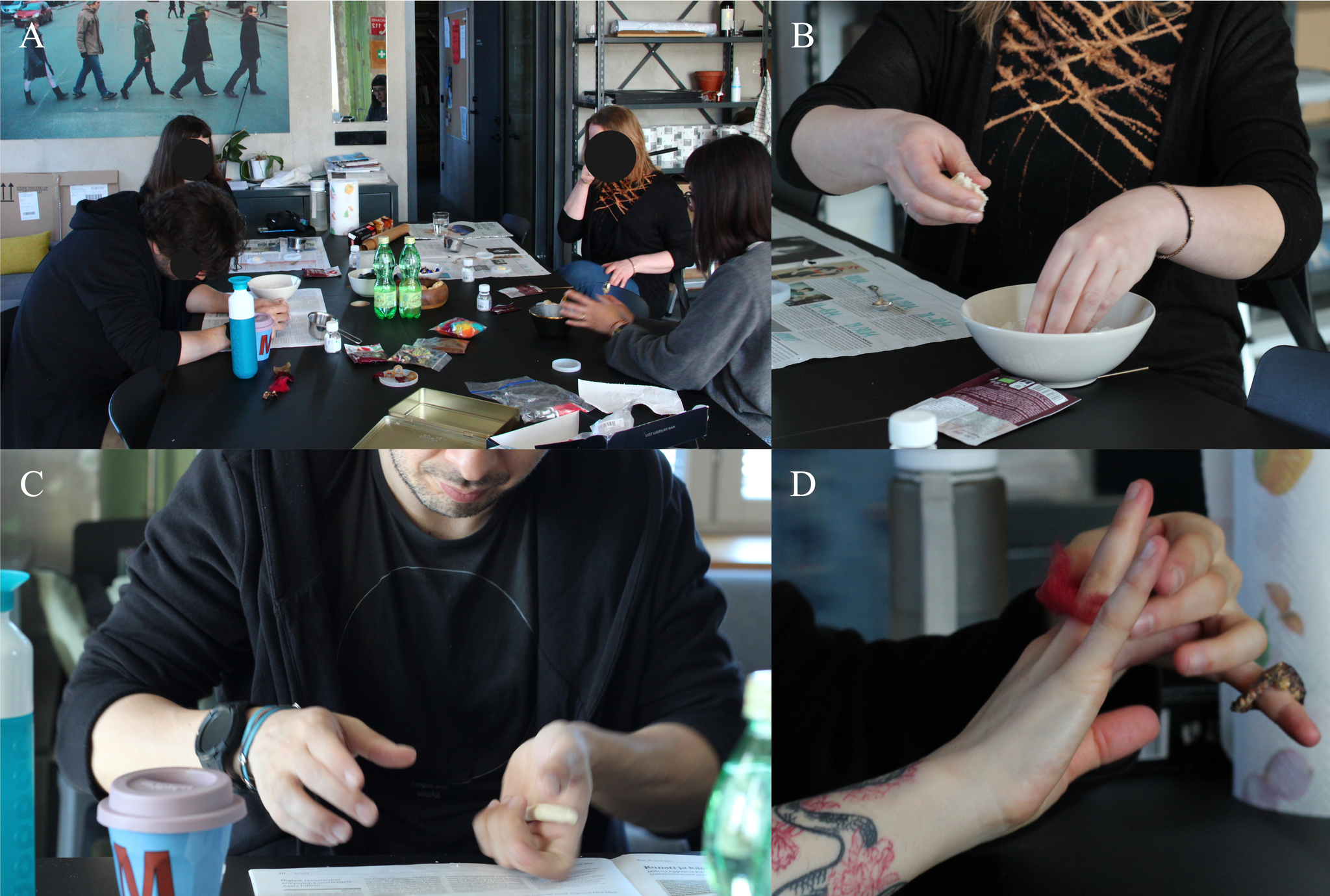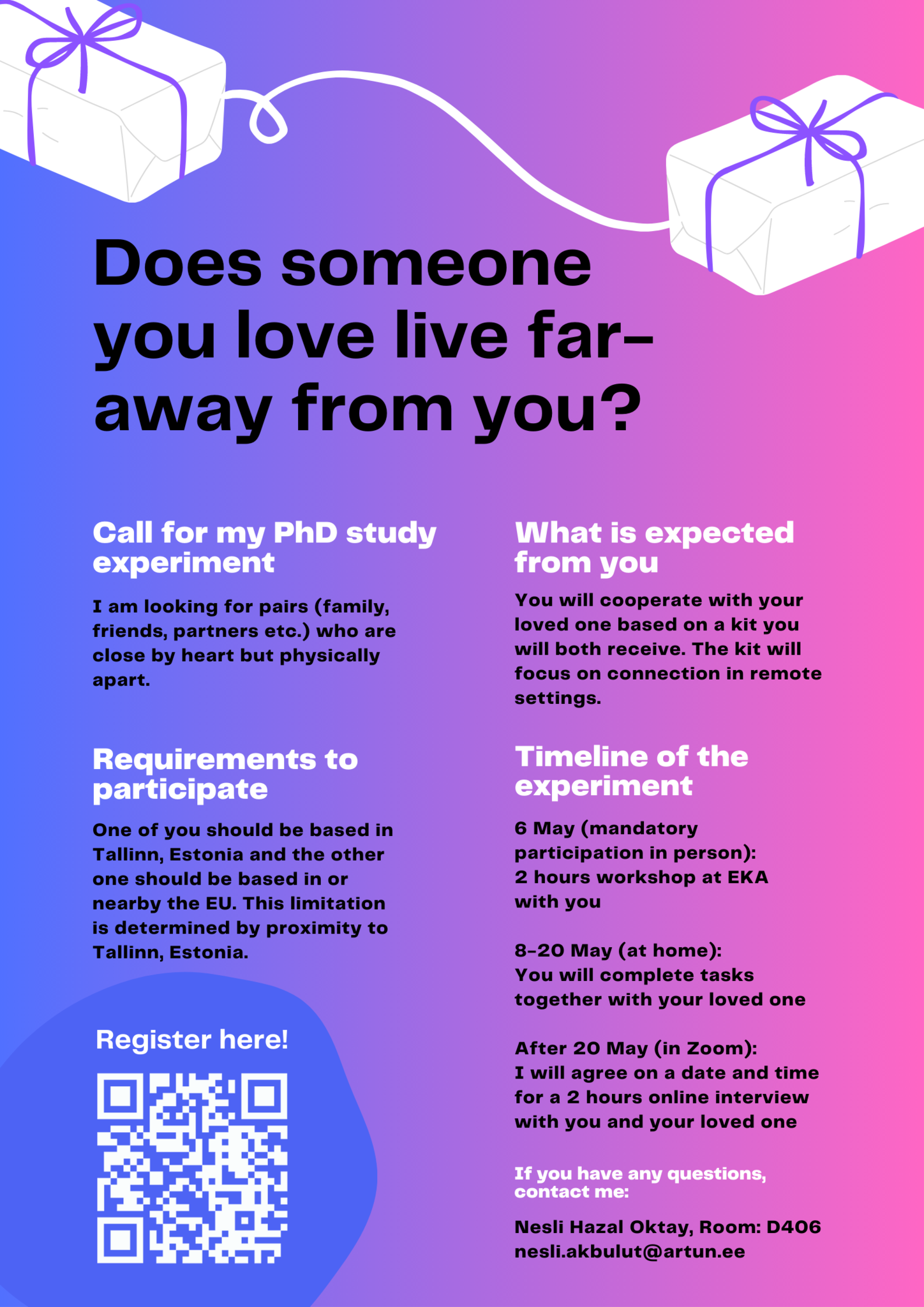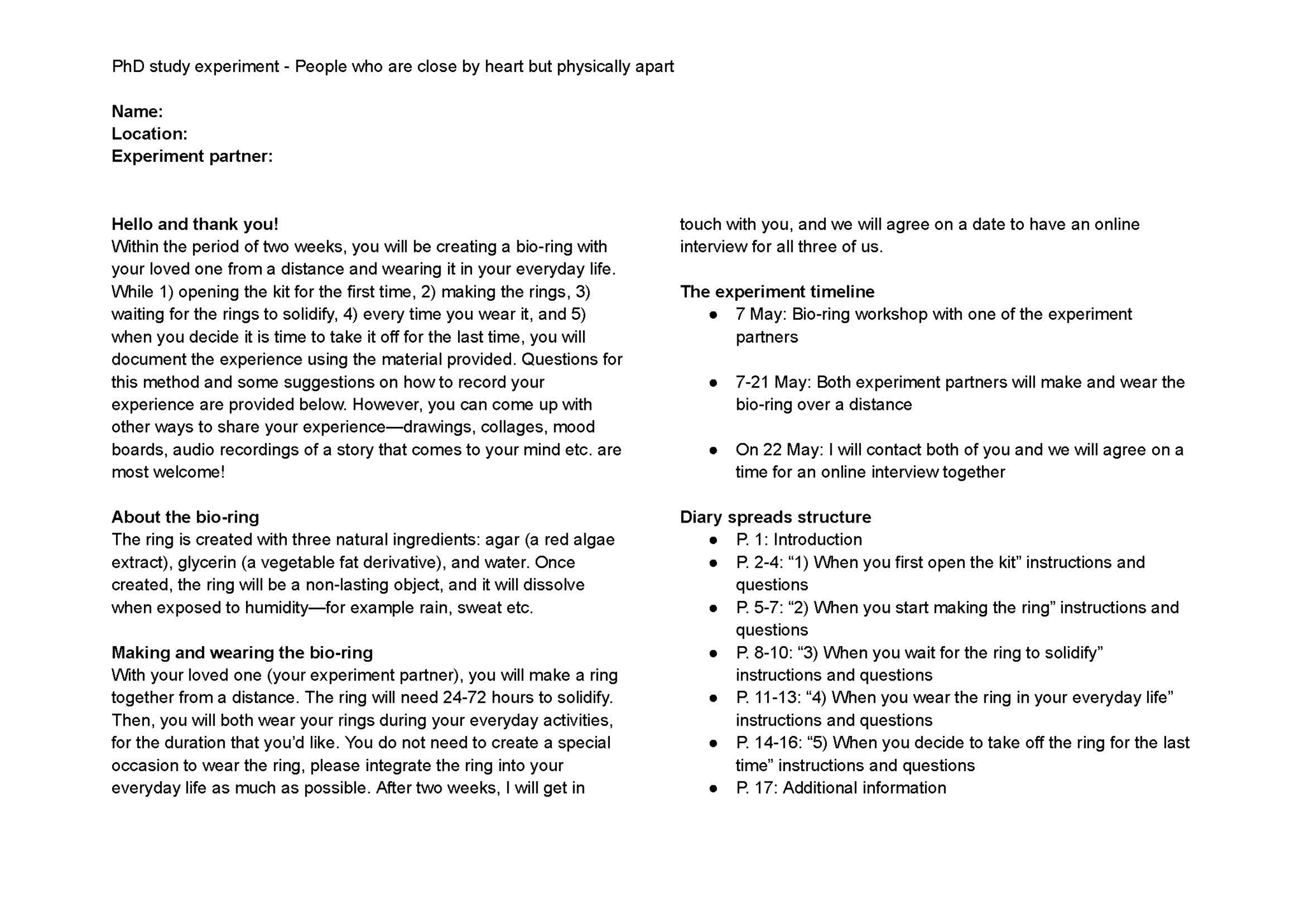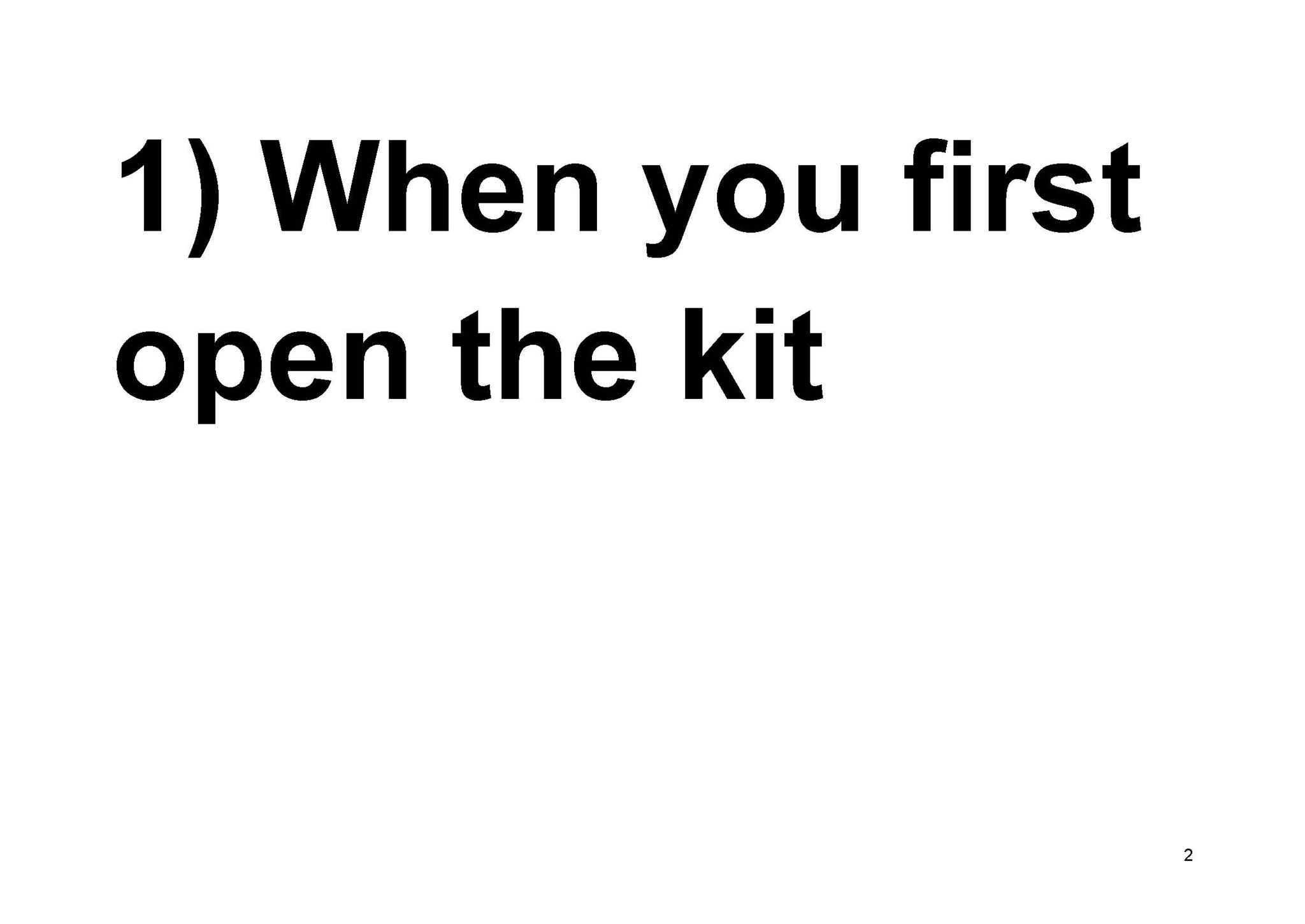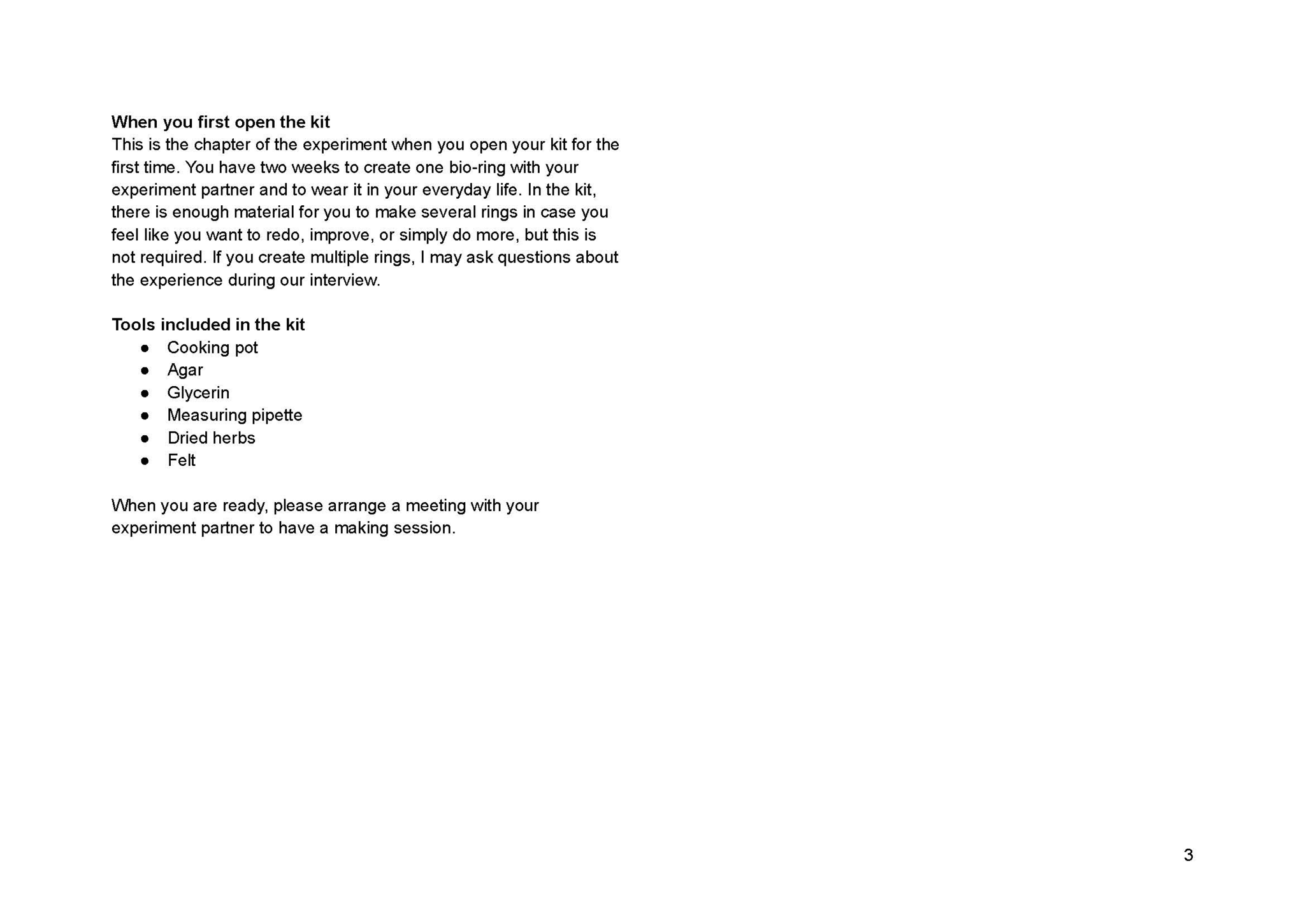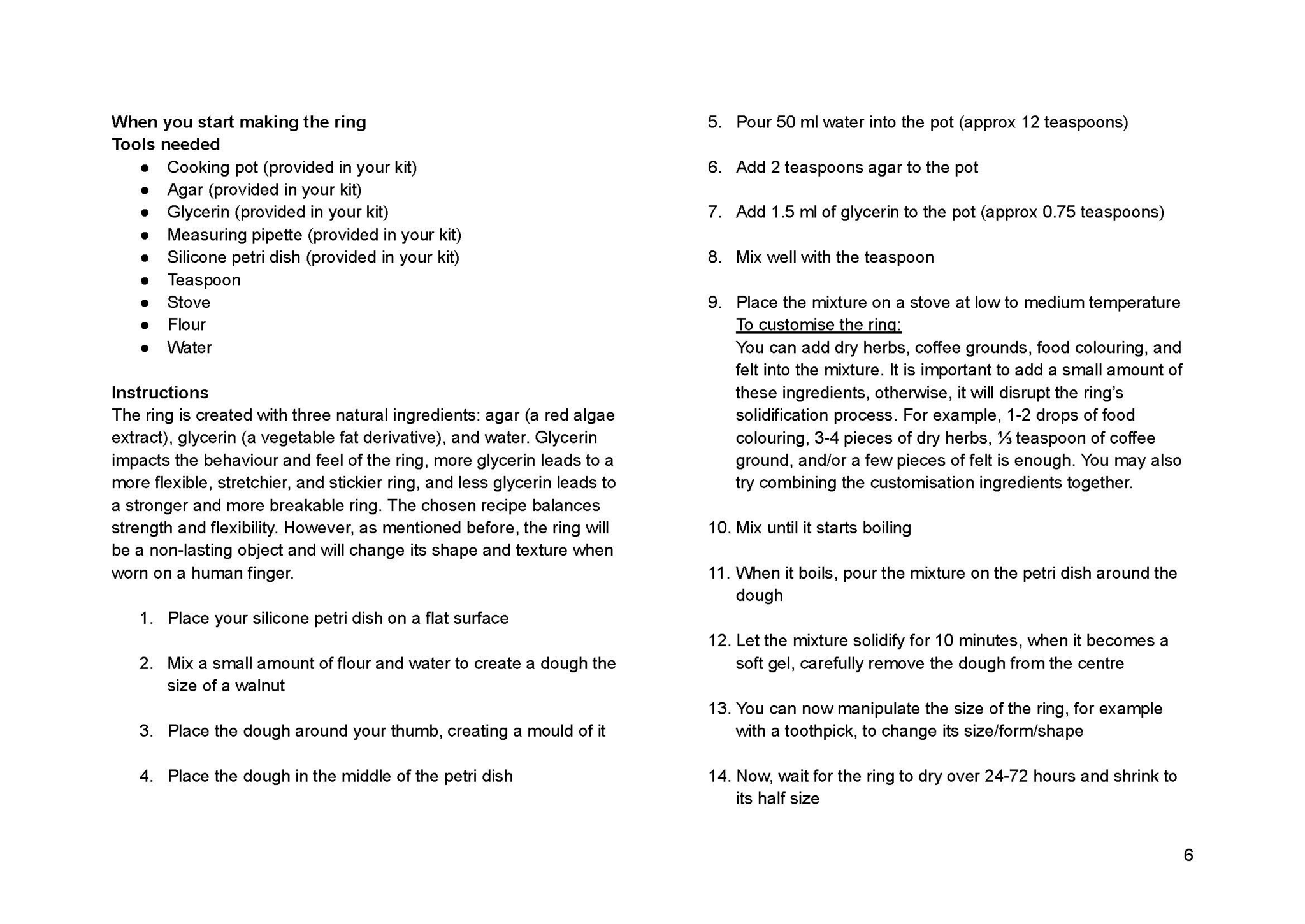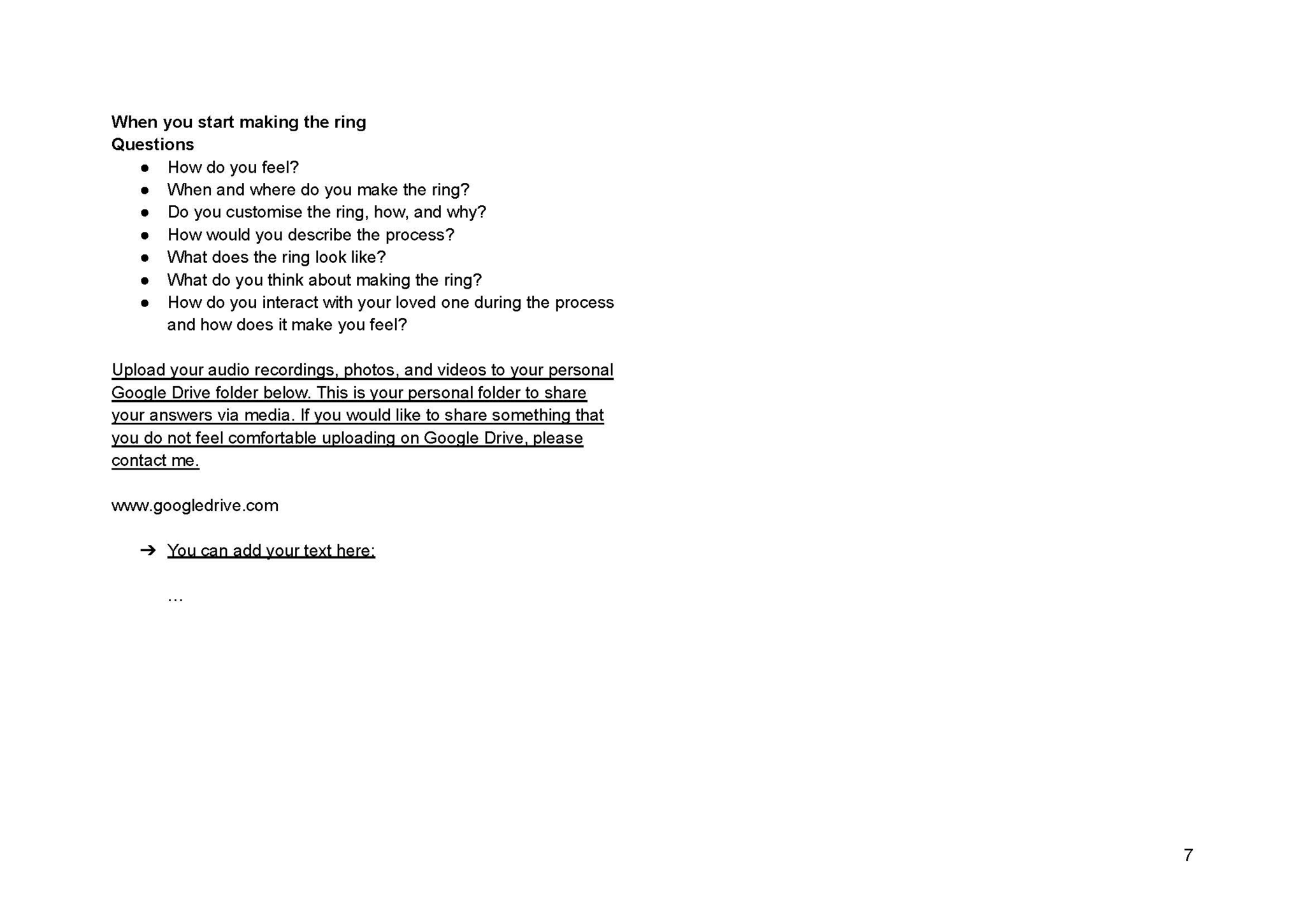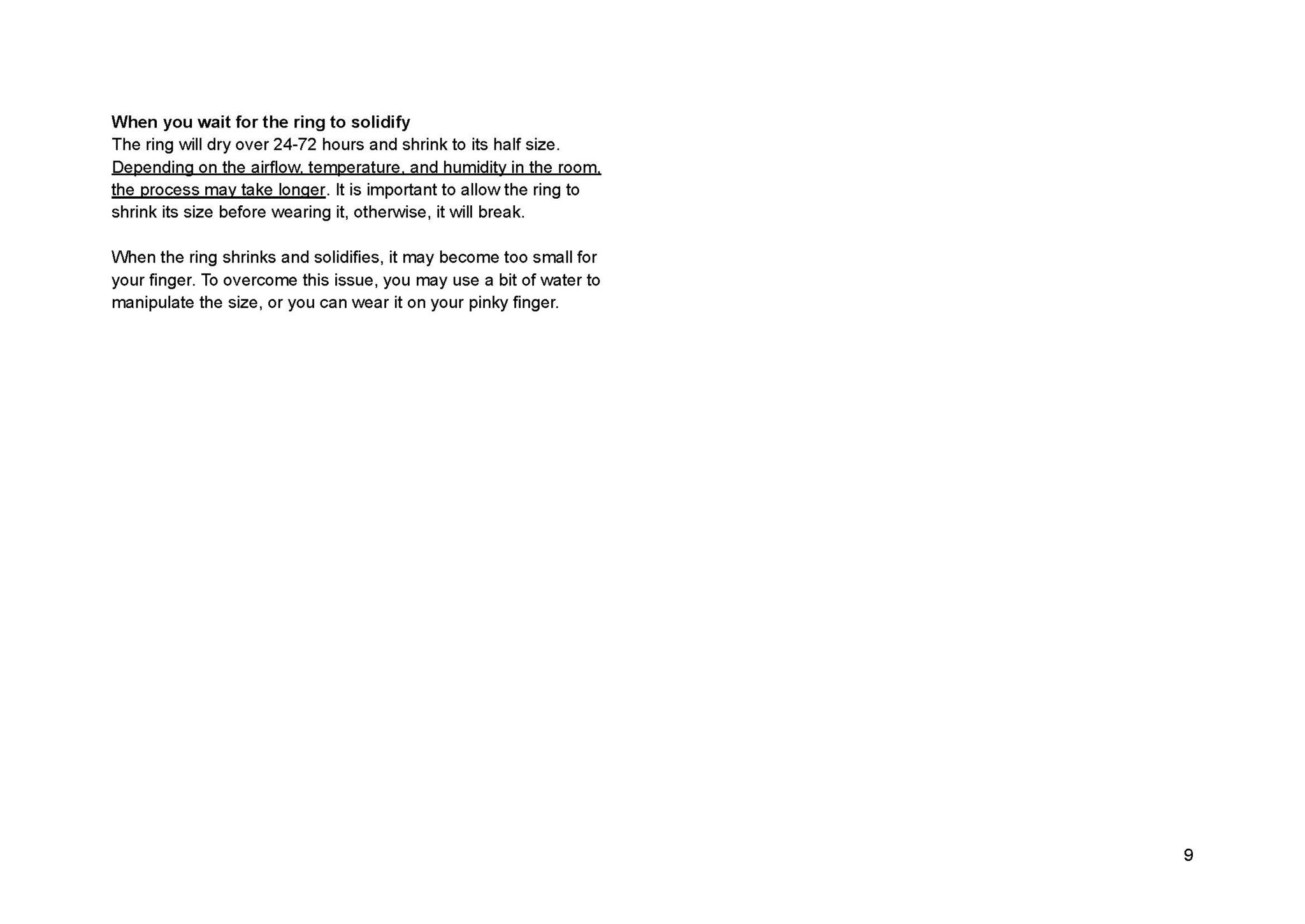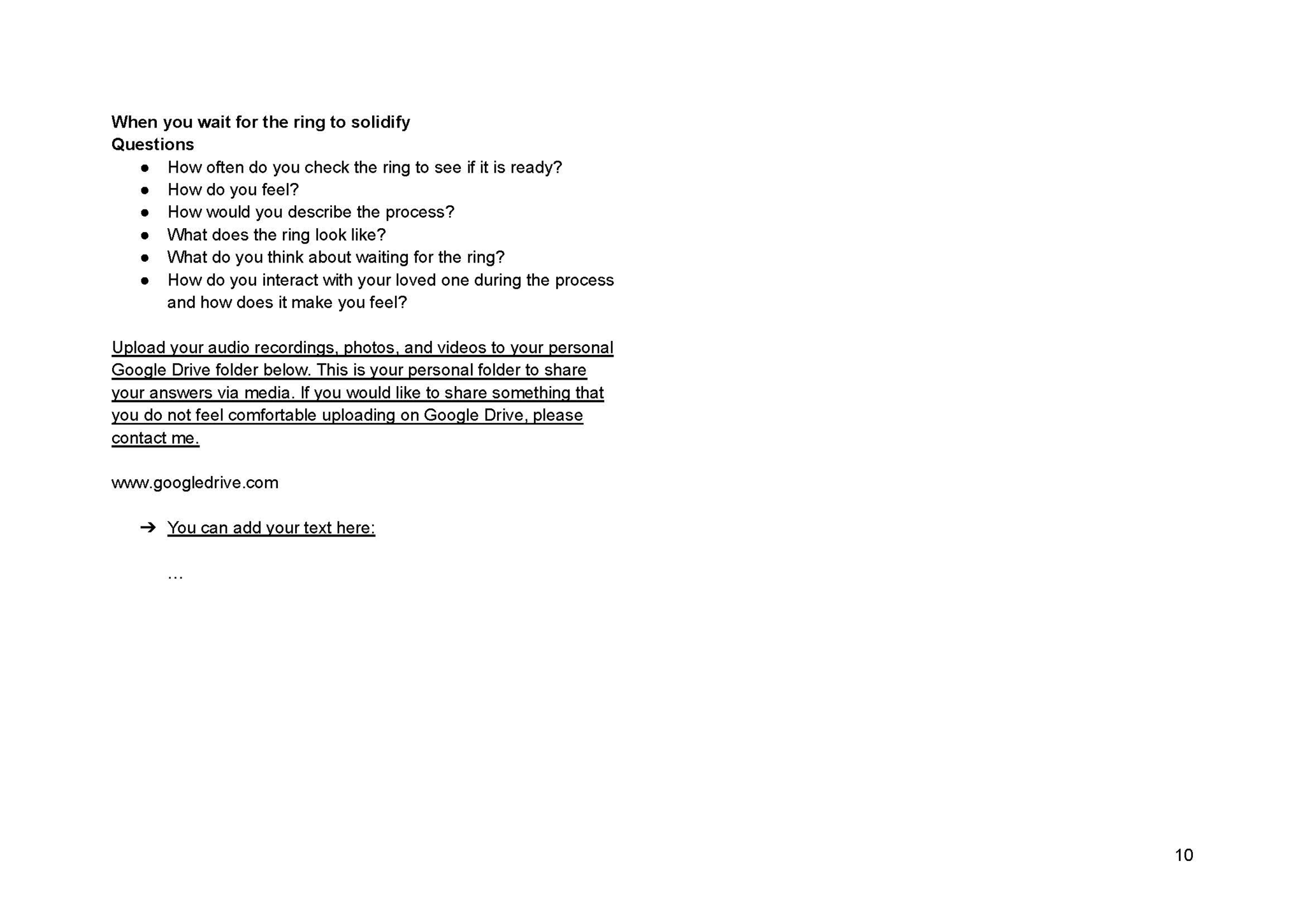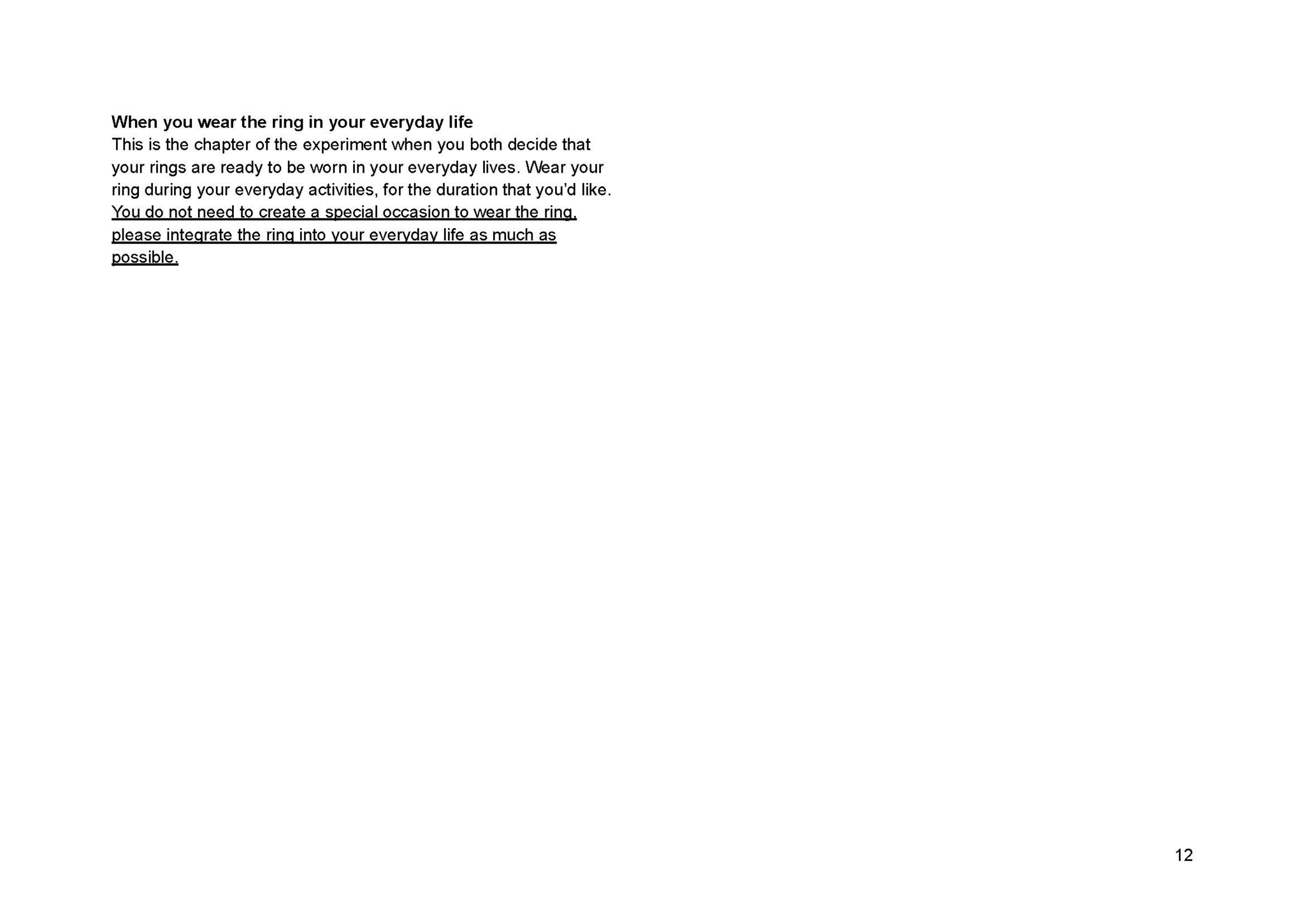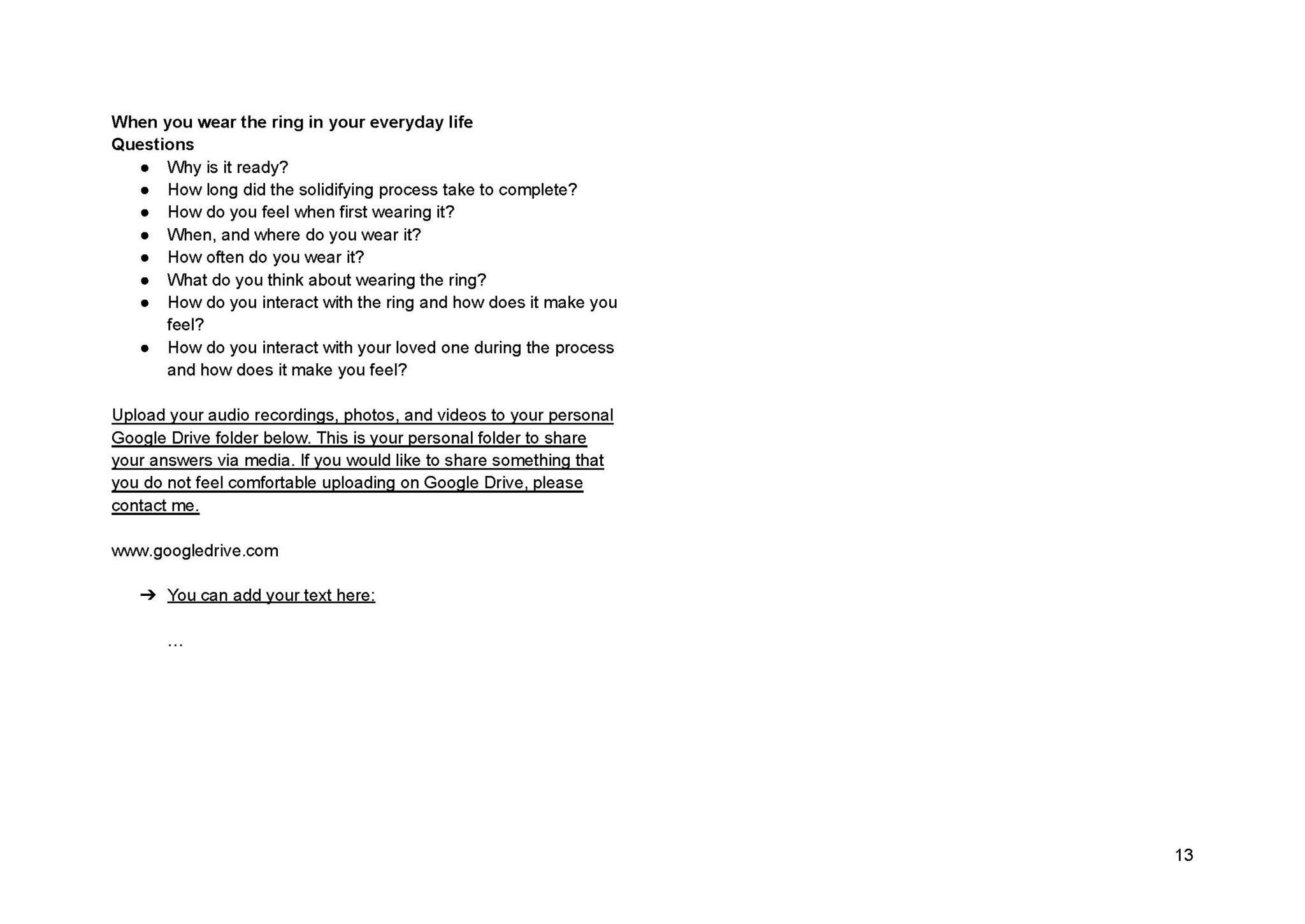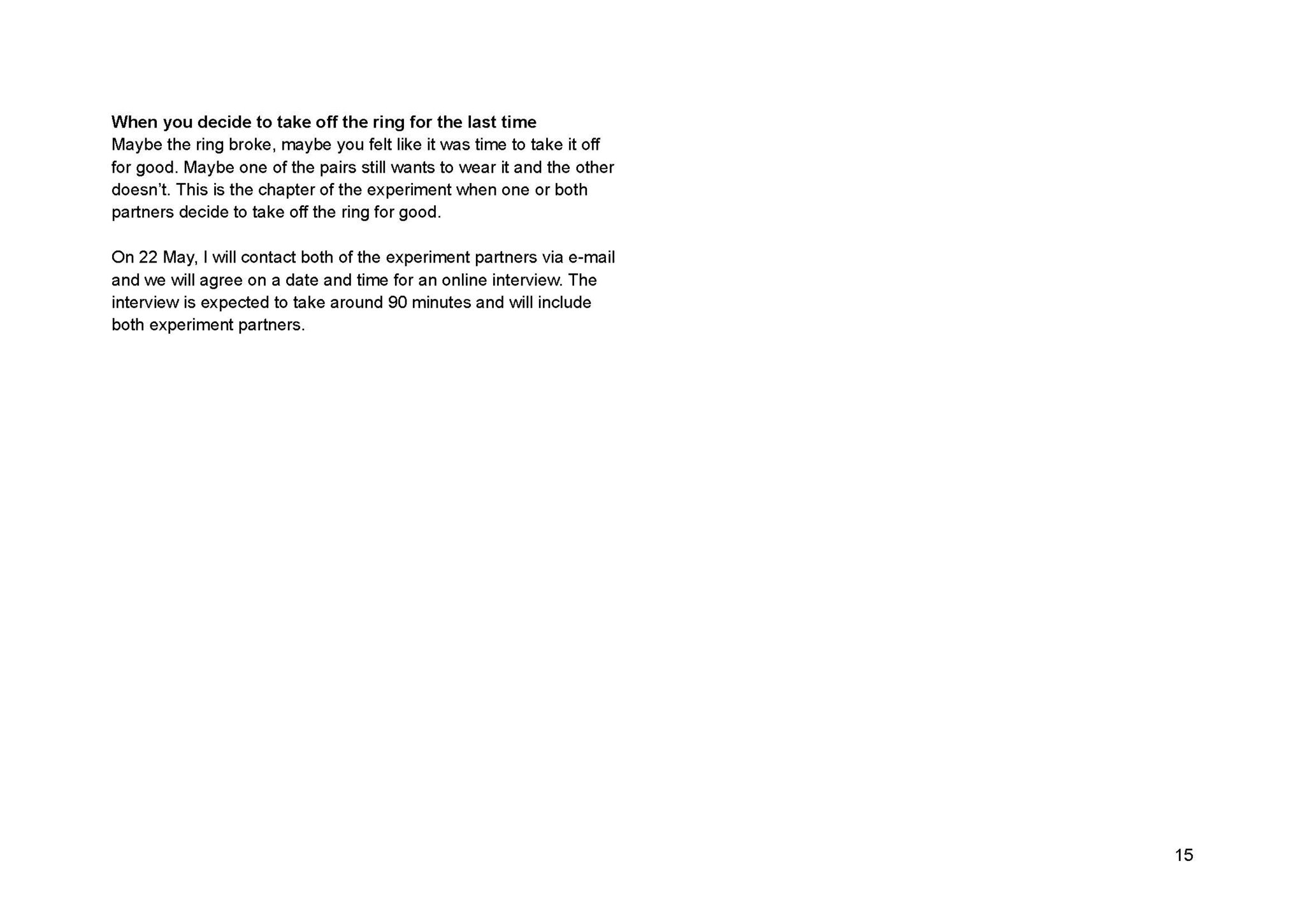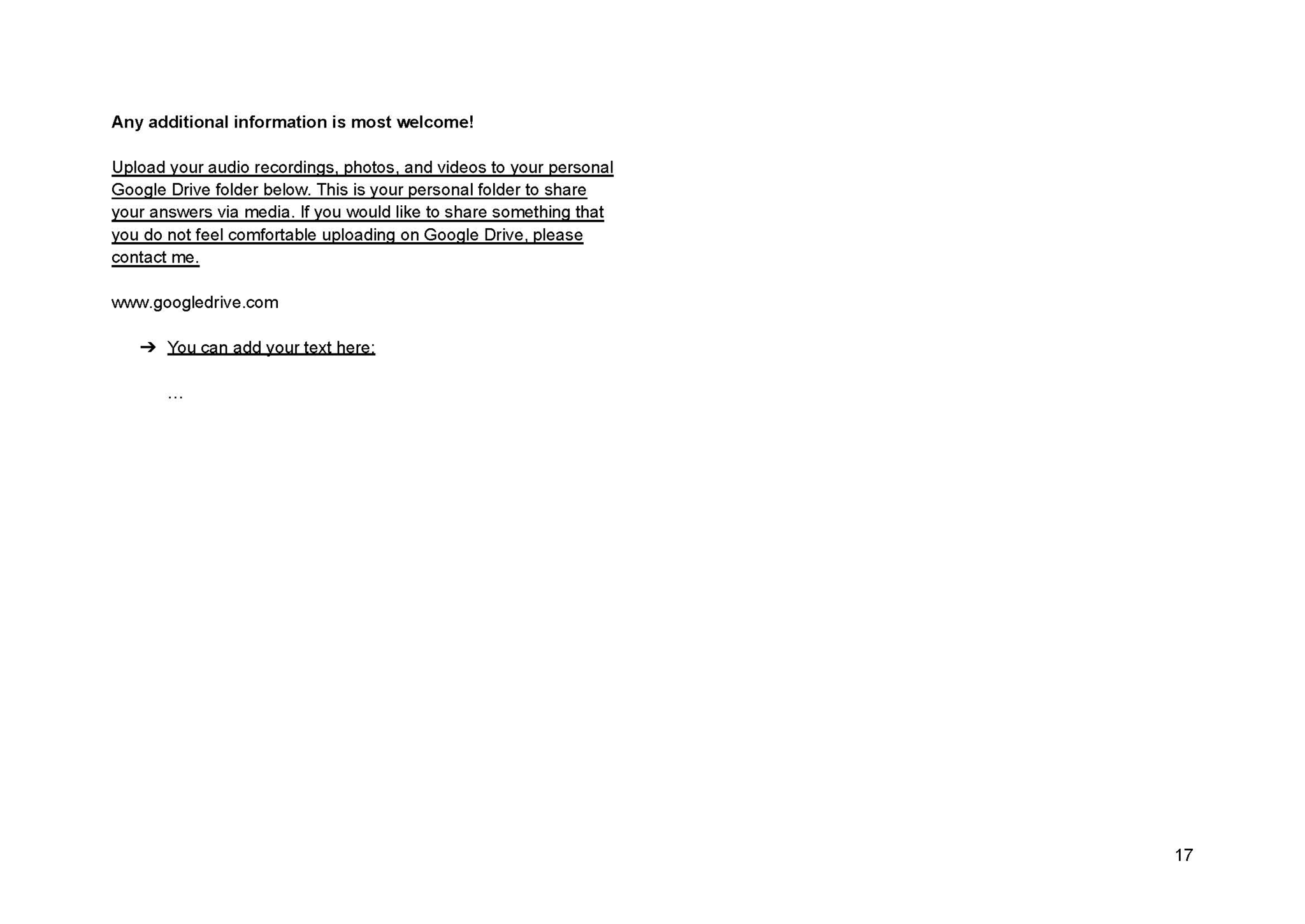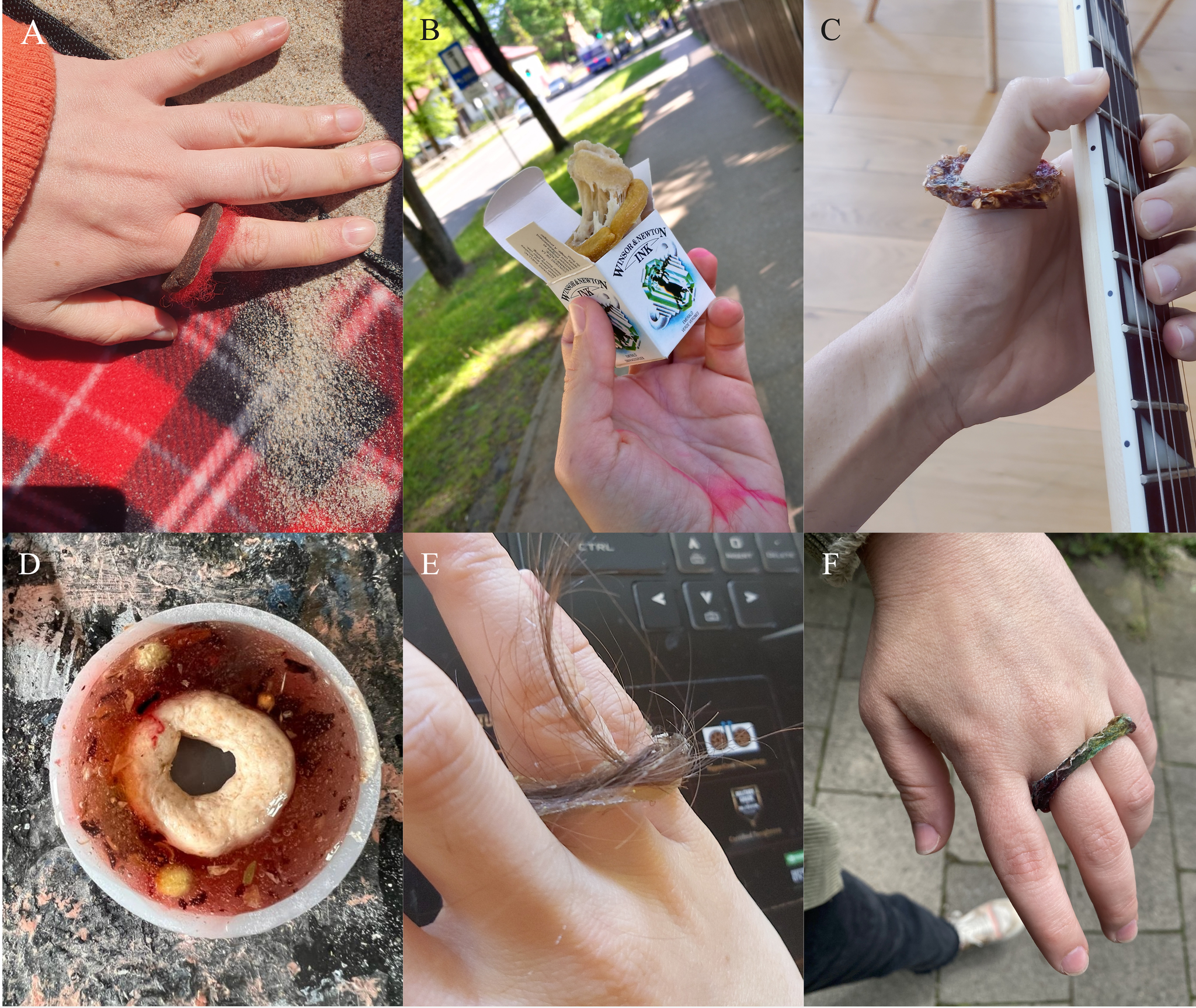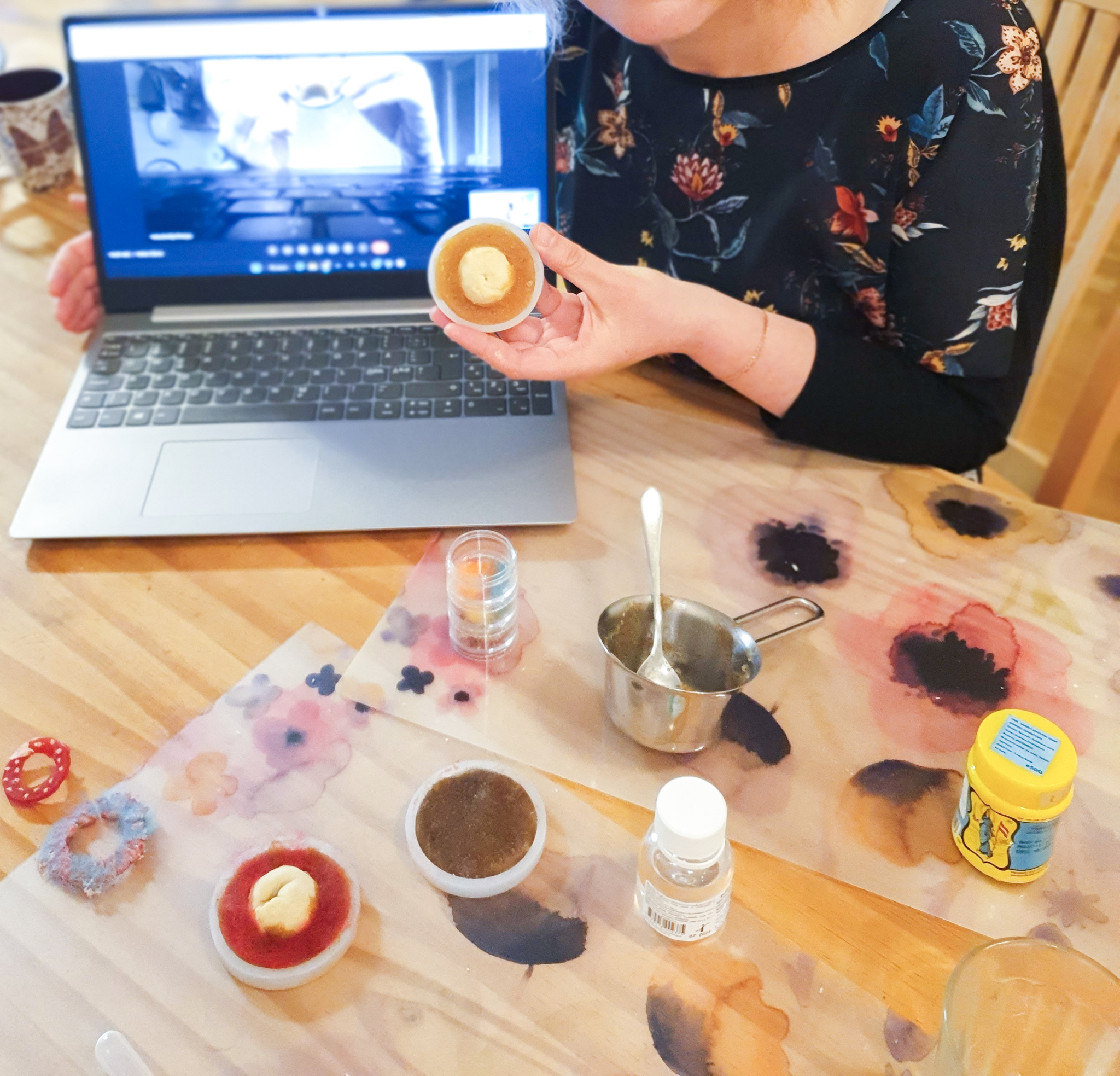Dissolving distances: Designing close-to-body experiences for remote settings
Nesli Hazal Oktay
nesli.akbulut@artun.ee
Estonian Academy of Arts, Estonia
Abstract
I aim to offer embodied intimacy for people who are close by heart but physically apart. Specifically, I explore designing close-to-body experiences at a distance through intimate bio-rings, rings made of natural ingredients. Intimate bio-rings are highly customizable, can be biodegraded, and start dissolving when exposed to humidity e.g.: rain, sweat etc. The idea of creating a non-lasting object to be worn on the body—that required care, that was ambiguous and tangible—was a result of a prior user study of cultural probing and embodied design ideation. I further experimented with intimate bio-rings by making the ring and wearing it in everyday life together with my father, whom I live far away from. In this paper, I showcase a user study with 3 pairs (6 participants) that made intimate bio-rings at their homes while self-reported and self-documented their personal experiences. They then further shared their meaning-makings with me through an interview. Overall, participants found intimate bio-rings to be supporting new understandings about intimacy at a distance. As a result, their experience of "distance" alters slightly or changes completely by i) embarking on a journey, ii) creating time and space to be together, and iii) carrying each other through a tangible object.
KEYWORDS: distances, intimacy, embodied design, user study
Introduction
In everyday life, while sharing the same space with a loved one—be it your close friend, family, or romantic partner—, you may not exchange information, but simply be together. Feeling close to someone does not solely consist of gazing at each other, but also in looking in the same direction. The experience of looking in the same direction fosters the sense of feeling close to someone resulting in building and experiencing intimacy between loved ones. However, sometimes people who are emotionally close find themselves physically distant from each other for short or long periods. This physical distance can be an important limitation in building and experiencing intimacy (Andersen et al., 2002). Defining intimacy as "the quality of close connection between people and the process of building this quality” (Jamieson, 2011, p. 1), this paper focuses on intimacy at a distance.
Could a close-to-body experience be designed to support intimacy at a distance? With this question, my aim was not to design new prototypes as a solution to distances between loved ones, rather I wanted to experiment with ways of building and experiencing intimacy at a distance. I aimed to take a step back from technological prototypes, to experiment with familiar habits to open a space for meaning-making. Therefore, I present in this paper a user study of how to support the remote intimacy between families and friends by bringing the body and physical materials into the conversation. I focus on the body to address the lack of physical closeness in intimacy from a distance; and on tangible materials, as they can be used as tools to concretely manifest abstract notions (Demir et al., 2023). To achieve this objective, I created intimate bio-rings, a close-to-body experience, building upon existing remote communication means while disrupting them. For implementation and analysis, I utilized a workshop, a cultural probe study, and semi-structured interviews involving 3 pairs (6 participants).
Related Work
In order to nourish their emotional closeness over distance, loved ones seek alternative means of communicating (Andersen et al., 2002). Today, communication with loved ones over a physical distance is often mediated through phone and video calls, online chats, sending postcards, letters, and packages to each other. These ways of communication can support intimacy, but they are limited in bodily interactions. Related work in the field of Interaction Design and HCI, focuses on communication at a distance with the help of emerging technologies. For example, in “Feather, Scent, and Shaker”, Strong and Gaver (1996) build on the notion of awareness, and three concepts are designed to enrich the feeling of togetherness at a distance through collaborative systems. These concepts offer simple and poetic indications of attention and emotion. Similarly, in “FARAWAY”, Andersen et al. (2002) explore intimate communication, focusing on the concepts of emotional closeness and physical distance. As a result, they design exploratory tools to allow people to assert their presence inside the emotional space. More recently, Beuthel et al. (2021) explored remote communication through design interventions. With their interventions, they aim to disrupt current communication routines to invent, reinvent, and redesign the existing ways of remote communication.
The role of the body is fundamental in our meaning-generation process, therefore, influencing how humans communicate with themselves and each other (Núñez-Pacheco, 2018). In this light, Loke and Robertson (2013) present a design methodology of "moving and making strange", “an approach to movement-based interaction design that recognizes the central role of the body and movement in lived cognition” (Loke & Robertson, 2013 p.7). "Moving and making strange" offers insights into bodily concepts concerning the self, others, materials, and technologies that interact with and surround the human body. Adopting the methodology of “moving and making strange”, the experiment presented in this paper takes inspiration from these previous works and applies a similar approach to the design and exploration of a close-to-body experience for remote settings. By embracing the "moving and making strange" methodology, my objective is to prompt both my participants and myself to reexamine distant bodies. More precisely, I seek to highlight the connection between far-away bodies and the intimacy that individuals cultivate across distances. This process consists of a reflective experience through the body in movement that brings focus to the qualities of the bodily interactions. In this way, the aim becomes strengthening the awareness of remote intimate relationships through unusual shared activities and close-to-body objects.
Method
Research context
The experiment presented in this paper is part of my 4-year doctoral research study. In this study, I explore ways of offering embodied intimacy at a distance. The study is divided into 3 experiments and is grounded in my personal struggles and curiosities towards the intimacy that I maintain with my parents in remote settings. My own remote intimacy experiences began in the summer of 2017 and are ongoing during the writing of this paper.
In the first experiment, I began by gathering the personal experiences of 5 participants from a cultural probe study (Gaver et al., 1999) where I focused on the transmission and perception of hand gestures and overall body language in remote communication settings (Oktay, 2022). Following this cultural probe study, I conducted embodied design ideation and collaborated with a dancer to look for opportunities in the body (Oktay et al., 2023). The collaboration supported the translation of the gathered data into design mood boards and ideas (Demir et al., 2023). This first experiment underlined that the close-to-body experiences should manifest the following characteristics: ambiguity, requiring care, and tangibility. In different ways, these characteristics supported the creation of new perceptions and close-to-body engagements for the participants, including the dancer.
In the second experiment, I turned to my own body and my relationship for the first time in my design research, having as an end goal to design for others. With the findings from the previous experiment, I designed making and wearing intimate bio-rings as the close-to-body experience. Adopted from the recipe of ALGANYL (Bell et al., 2022), the intimate bio-rings are created with three natural ingredients: agar (a red algae extract), glycerin (a vegetable fat derivative), and water (Figure 1). In this experiment, I focused on exploring the intimate place that is created by making something new and fragile together with my father, and wearing the creation in our daily lives. On account of the findings of this experiment, I gained two main methodological insights. I understood that i) when inviting other pairs to a similar experiment, one of the pairs should be closely informed about how to make the ring and ii) I should support the customization possibilities of the intimate bio-rings. Therefore, my last and third experiment began with a workshop with participants which will be presented in the next chapter. In this paper, I will be focusing on the last experiment of the study and discuss the implementation and analysis of intimate bio-rings involving 3 pairs (6 participants).
As a close-to-body experience, I chose making and wearing of rings specifically because rings are personal yet also visible objects, reminding themselves of their wearers and others throughout the day. Nearly every human wears (or has worn) rings for a variety of reasons, and the significance attached to wearing them can differ across cultures and individuals. For instance, wedding and engagement rings universally symbolize commitment and union between partners. Rings may also carry cultural or religious connotations, signifying achievements, accomplishments, or specific statuses such as class or championship rings. Additionally, today, digital rings serve specific functions like tracking heartbeats or locations. Some people wear rings to enhance an outfit to express personal style. In my case, I enjoy wearing rings with sentimental value, the majority of which have been gifted by my mother. These rings hold special significance as they serve as tangible reminders of my close bond with my family and I like the way they look. In essence, my decision to wear rings is a deeply personal one, and the motivations behind it can be diverse and multifaceted.
Experiment set-up
In this experiment, intimate bio-rings were used as cultural probes to gain new perspectives into the sense of intimacy at a distance. I recruited 3 pairs (pairs of friends and siblings) who experience intimacy in remote settings. Before starting the cultural probing, I led a 2-hour workshop (Figure 2) on making bio-rings with one of the pairs in a physical setting where we made various bio-rings together. After the 2-weeks long cultural probing, I conducted interviews with the pairs in an online setting.
For the cultural probing, the materials that were necessary to create intimate bio-rings(diary spreads with instructions, agar, glycerine, silicone petri dish, customization ingredients, measuring pipette, and mixing pot) were carefully chosen and placed in a kit to be distributed to the pairs. The kits had identical materials with a cohesive look to establish a sense of connectedness. The diary spreads were identical and were designed to be qualitative in nature. With this, I hoped to inspire participants to reflect on their experiences and ask them to answer open-ended questions rather than aiming for general data. A sample of the diary spread can be found in the section titled "Data Collection and Analysis".
Figure 2. Workshop before the cultural probing. A: Participants who are located in Tallinn are invited to a hands-on workshop about bioplastic making, the workshop is led by the author. B: P1 is engaging with materials provided by the author. C: P3 is creating his first bioplastic ring. D: P5 is engaging with the materials provided by the author.
Participants
Participants were recruited via an open call posted on social media channels. The open call was also printed as a physical banner (Figure 3) and hung on the walls inside and around the building of the Estonian Academy of Arts. People responded to the call by filling out an online questionnaire that was utilized to determine their eligibility. The selection criteria included that a participant must have been living in Tallinn and be separated from some/one of their loved ones (family, friends, lovers) by distance. In total, all three of the three applicants were selected to participate in the study with their loved ones. The limitation of location was determined by one of the pairs’ proximity to Tallinn, Estonia, and the other pairs’ ability to join a 2-hour long workshop on making bio-rings in a physical setting.
Pair 1 (Participant 1 & Participant 2)
Friends for +26 years
P1: Textile designer based in Estonia
P2: Multidisciplinary artist based in Latvia
“In college, we were feeding each other. We’re in solidarity.” -P2
Pair 2 (Participant 3 & Participant 4)
Siblings
P3: Quality assurance engineer based in Estonia
P4: Sculptor based in Turkey
"Despite the generational gap between us, we are like two friends who get very well along.” -P4
Pair 3 (Participant 5 & Participant 6)
Friends for +10 years
P5: Designer, researcher, and artist based in Estonia
P6: Doctoral student in philosophical logic based in Germany
"We already talk on Zoom all day. So like, this is something that yeah, we can just do it.” -P6
Data Collection and Analysis
Before starting to make and wear intimate-bio rings, the participants were first presented with study details (goals, procedure, data collection, time needed, etc.). For collecting the data, I relied on two approaches: i) online diary spreads that included instructions, questions, and suggestions on self-reporting and self-documenting the experience, and ii) semi-structured interviews with the pairs. In the online diary spreads (Figure 4), I asked the participants to individually respond to reflective questions after the steps of wearing and making rings in a written form and document the process with photos/videos/drawings, etc. Online diary spreads helped me gather insights into people's lives, experiences, and emotions related to the close-to-body experience.
Semi-structured interviews fostered a richer understanding of the participant's experiences, perspectives, and insights. After the cultural probe study, I conducted online interviews with pairs and followed a more conversational and face-to-face investigation of the subject matter. During these interviews, I was inspired by the Placebo Project (Dunne & Raby, 2002) to pose reflective questions on the experience: When you talk to your friends/family, how do you describe the ring? Where is the ring now, why is it there? How did you feel wearing it? Do you start to interpret its' meaning? Has the experience of making and looking after the ring had an effect on the way you think about the intimacy between each other? If you had to give the ring to somebody else, who would you give it to and why? What kinds of people might want to participate in an experience like this? Did anything really annoy you about the experience? Did anything really surprise you about the experience? How would you describe your new learnings about the intimacy that you maintain and nourish at a distance?
After collecting all the data, I reviewed them collectively and applied the affinity diagramming (Lucero, 2015) method to analyze them. Through comparing, contrasting, and interpreting the data, I identified reoccurring themes that appeared to be relevant to remote intimacy, and I will be discussing them in the next chapter.
Results and Discussion
Intimate bio-rings is an exploration of ways of building and experiencing intimacy at a distance, taking a step back from technological prototypes, but building on familiar intimate habits while disrupting them to open a space for meaning-making. In this experiment, the body and physical materials are brought into the conversation through moving and making strange. Intimate bio-rings add a physical element to the body while giving tangible and visible form to an abstract notion i.e. intimacy. Overall, I see that the workshop before the cultural probing supported the participants in creatively engaging with the materials provided. They all customized their rings and their rings were made to be eye-catching and special (Figure 5). Therefore, they acted as conversation starters. All participants stated that they engaged in conversations with other people (e.g.: their family members, friends, etc.) about their ring.
Figure 5. Participants’ intimate bio-rings. A: P1’s custom ring has bright red wool fiber added to it to change the texture, the participant stated that she mainly focused on the tactility of the ring when customizing it. B: P2’s ring ended up as a big lump—in their words—to be “proudly” carried around in a container. C: P3’s ring included dried red pepper flakes and smelled spicy. D: P4 stated that she appreciates wearing personalized items and she enjoyed mixing things together while customizing her ring with dried herbs. E: P5 decided to add her own body hair to the ring. F: P6 customized her ring by adding wool fiber and dried herbs to it.
As mentioned earlier, intimate bio-rings disrupted the familiar ways of communication. The familiar habit of “cooking, crafting together” became “making bioplastic together over the distance”. Secondly, the familiar habit of “sending messages or photos” became “sending messages or photos of the shared experience that is translated to a tangible object i.e. a bio-ring”. Lastly, the familiar habit of “hugging, feeling physically close” became “wearing a bodily reminder of the other through a tangible object i.e. a bio-ring”. While shifting the familiar habits into more ambiguous ones, the moving and making strange occurred for the participants via physical sensations (P1, 3, and 4 described the ring as “weird”, P3 self-reported that wearing the ring was “uncomfortable”) and via emotional sensations (P2 self-reported that the experience evoked the sensation of missing her loved one, P4 self-reported that she found the idea of throwing the ring away to be annoying, and P6 self-reported that the very beginning of the experiment evoked regret). In this light, when analyzing the participants’ responses, I see that the moving and making strange support new understandings about "distance".
Embarking on a journey
“When you look at it too literally, a ring on our finger may not mean so many things, but the steps we took to arrive at that moment, or the work we put in it and how we cared for it, it is all about the journey we took together.” -P4
The experiment meant embarking on a journey together while feeling closer physically or reminiscing shared memories. For Pair 1, the process felt like “art therapy”, taking them to different memories and feelings. For Pair 2, it was a similar experience, while making the ring P2 reminiscent of their sibling activities from the past when they were living in the same city and sharing the same space. Lastly, Pair 3 made the rings while P5 guided P6, and wanted to follow her instincts. During this process, P6 felt as if they were “physically together, doing things in person”.
Creating time and space to be together
"It was great to have a reason to call her more often…We asked ourselves why we do not use this as a habit to meet more often via online just for a cup of coffee and some co-making." -P1
The experiment supported the pairs in creating time and space to be together while supporting the feeling of togetherness at a distance. Pair 1 had conversations around deeply personal topics. Even though they are close friends for more than 26 years, they started calling each other "loved ones" during the experiment. They cried and laughed together and P2 realized that they needed to continue nourishing their friendship and engage in such "healing" activities together. Pair 2 shared that the experiment felt like an “add-on” to their ongoing conversations. In reflection, P4 shared that this was a transformative experience together with her brother for her. Pair 3 shared that they are almost in constant communication and felt like this experiment gave them a chance to talk for, in their words, an “extended period of time”. After the making process, they stayed on the Zoom call for another 1-2 hours and just chatted.
Carrying each other through a tangible object
“When [my friend] was wearing the ring to the dinner, I was thinking, oh, it's so nice that like now she has to talk about me at the dinner…I kind of find found it funny that the experiment carries me around whoever she meets at that point.” -P6
Through the experiment, the pairs carried each other to places, disrupting the physical understanding of distance. Pair 1 experienced a positive surprise while carrying each other to the sea. P1 was on an island, at the seaside, wearing her ring when she accidentally called P2. By chance, when received the call, P2 was painting a sea view at her studio. They shared that they usually do not call each other spontaneously but at that moment they decided to keep talking, firstly about the sea, but then about their emotions. Some participants (P2,3,5, and 6) mentioned that the ring became something else once it was integrated into everyday life or symbolized the shared experience of making it. These participants kept the ring and did not yet throw it away at the time of our interview which was approximately one week after the cultural probing. On the other hand, P1 and P4 disposed of the ring before the interview. For P1, "the ring felt loaded with energies and emotions" and she “sacrificed” her ring in the Swedish labyrinth on the island Aegna of Estonia. P4 disposed of the ring when it got moldy.
Conclusion
Intimate bio-rings addressed the forms of interaction between beloved ones who are far away from each other. As a result, I discussed that participants’ experience of "distance" altered slightly or changed completely by i) embarking on a journey, ii) creating time and space to be together, and iii) carrying each other through a tangible object. As a limitation of this user study, pairs that signed up for the experiment had at least one person with a creative background and therefore influenced the responses gathered. For future work, involving people with different backgrounds could result in new findings and directions.
While this experiment specifically referred to intimacy between humans who chose to be far away from each other for their work and study, I speculate that the findings might also apply to other contexts and situations. For instance, a political approach could guide this study, shifting the scope to dislocated people—loved ones who were forced to be far away from each other. Expanding the application of intimate bio-rings could thus open up new ways to intimately build toward connections, and entanglements from a more social, and political view.
Acknowledgments
I would like to thank Kristi Kuusk and Danielle Wilde for their continuous feedback and support. I am also grateful to Oscar Tomico and Verena Fuchsberger for reviewing this design experiment and providing their valuable feedback and thought-provoking questions. Lastly, I would like to express my gratitude to the participants of this study, for allowing me to be part of their intimate journeys.
References
Andersen, K., Jacobs, M., & Polazzi, L. (2002). FARAWAY. Interaction Design Institute Ivrea.
Bell, F., Al Naimi, L., McQuaid, E., & Alistar, M. (2022). Designing with Alganyl. In Sixteenth International Conference on Tangible, Embedded, and Embodied Interaction, 1–14. https://doi.org/10.1145/3490149.3501308
Beuthel, J. M., Hofer L., & Fuchsberger V. (2022). Exploring Remote Communication through Design Interventions: Material and Bodily Considerations. In Nordic Human-Computer Interaction Conference. NordiCHI ’22. Association for Computing Machinery, New York, NY, USA, Article 54, 13 pages. http://dx.doi.org/10.1145/3546155.3546650
Demir, A. D., Oktay, N. H.*, & Kuusk, K. (2023). Cultivating and Eliciting Felt Experiences for Design Use: Physical Manifestations of Abstract Bodily Experiences. In Design Research Society Special Interest Group: Experiential Knowledge. EKSIG 2023, Milan, Italy. https://www.eksig2023.polimi.it/assets/EKSIG-Proceedings.pdf, 206−224. *joint first authors.
Dunne, A., & Raby, F. (2002). The Placebo project. In Proceedings of the 4th Conference on Designing Interactive Systems: Processes, Practices, Methods, and Techniques, 9–12. https://doi.org/10.1145/778712.778714
Gaver, W., Dunne, A., & Pacenti, E. (1999). Design: Cultural Probes. Interactions, 6, 21–29. https://doi.org/10.1145/291224.291235
Jamieson, Lynn. (2011). Intimacy as a Concept: Explaining Social Change in the Context of Globalisation or Another Form of Ethnocentricism?. Sociological Research Online. 16. https://doi.org/10.5153/sro.2497
Loke, L., & Robertson, T. (2013). Moving and making strange: An embodied approach to movement-based interaction design. In ACM Transactions on Computer-Human Interaction. TOCHI, 20. https://doi.org/10.1145/2442106.2442113
Lucero, A. (2015). Using Affinity Diagrams to Evaluate Interactive Prototypes, Human-Computer Interaction – INTERACT 2015. INTERACT 2015. Lecture Notes in Computer Science(), vol 9297. Springer, Cham. https://doi.org/10.1007/978-3-319-22668-2_19
Núñez-Pacheco, C. (2018). Reflection through Inner Presence: A Sensitising Concept for Design. Multimodal Technologies and Interaction, 2(1), 5. https://doi.org/10.3390/mti2010005
Oktay, N. H. (2022). Design placebos for the impossibility of empathy in videotelephony. In Design Research Society. DRS2022. https://doi.org/10.21606/drs.2022.598
Oktay, N. H., Wilde, D., & Kuusk, K. (2023). Conversations with the body of the other: A three-step dialogical process. In Nordes Conference Series. NORDES 2023. https://doi.org/10.21606/nordes.2023.58
Strong, R., & Gaver, W. W. (1996). Feather, Scent, and Shaker: Supporting Simple Intimacy. In Computer Supported Cooperative Work (CSCW ’96).
